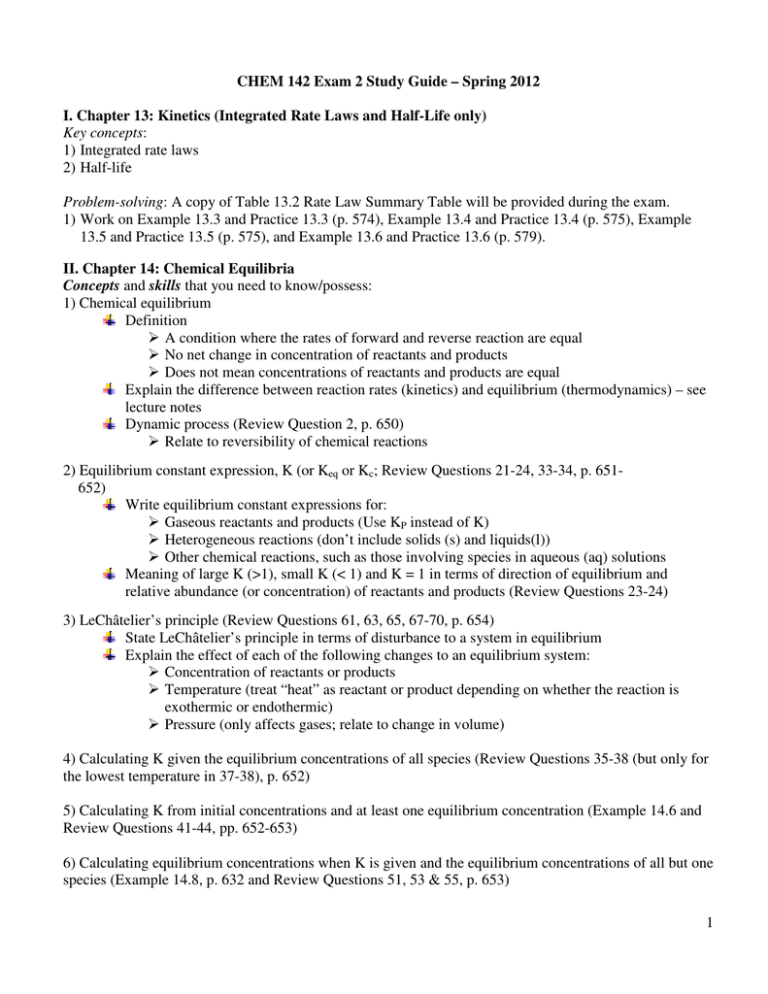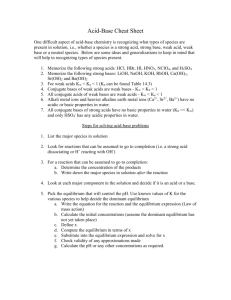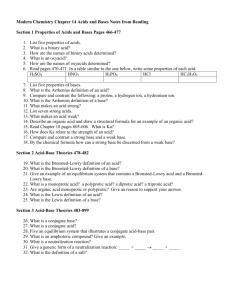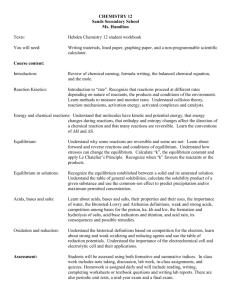CHEM 142 Exam 2 Study Guide – Spring 2012
advertisement

CHEM 142 Exam 2 Study Guide – Spring 2012 I. Chapter 13: Kinetics (Integrated Rate Laws and Half-Life only) Key concepts: 1) Integrated rate laws 2) Half-life Problem-solving: A copy of Table 13.2 Rate Law Summary Table will be provided during the exam. 1) Work on Example 13.3 and Practice 13.3 (p. 574), Example 13.4 and Practice 13.4 (p. 575), Example 13.5 and Practice 13.5 (p. 575), and Example 13.6 and Practice 13.6 (p. 579). II. Chapter 14: Chemical Equilibria Concepts and skills that you need to know/possess: 1) Chemical equilibrium Definition A condition where the rates of forward and reverse reaction are equal No net change in concentration of reactants and products Does not mean concentrations of reactants and products are equal Explain the difference between reaction rates (kinetics) and equilibrium (thermodynamics) – see lecture notes Dynamic process (Review Question 2, p. 650) Relate to reversibility of chemical reactions 2) Equilibrium constant expression, K (or Keq or Kc; Review Questions 21-24, 33-34, p. 651652) Write equilibrium constant expressions for: Gaseous reactants and products (Use KP instead of K) Heterogeneous reactions (don’t include solids (s) and liquids(l)) Other chemical reactions, such as those involving species in aqueous (aq) solutions Meaning of large K (>1), small K (< 1) and K = 1 in terms of direction of equilibrium and relative abundance (or concentration) of reactants and products (Review Questions 23-24) 3) LeChâtelier’s principle (Review Questions 61, 63, 65, 67-70, p. 654) State LeChâtelier’s principle in terms of disturbance to a system in equilibrium Explain the effect of each of the following changes to an equilibrium system: Concentration of reactants or products Temperature (treat “heat” as reactant or product depending on whether the reaction is exothermic or endothermic) Pressure (only affects gases; relate to change in volume) 4) Calculating K given the equilibrium concentrations of all species (Review Questions 35-38 (but only for the lowest temperature in 37-38), p. 652) 5) Calculating K from initial concentrations and at least one equilibrium concentration (Example 14.6 and Review Questions 41-44, pp. 652-653) 6) Calculating equilibrium concentrations when K is given and the equilibrium concentrations of all but one species (Example 14.8, p. 632 and Review Questions 51, 53 & 55, p. 653) 1 III. Chapter 15: Acid-Base Equilibria A. Terminologies and Concepts 1. Acid reflux or GURD 2. Identify several general properties of acids 3. Identify several general properties of bases 4. Binary acids - define and give examples 5. Oxyacids - define and give examples 6. Neutralization 7. Arhhenius definitions - acids vs. bases; give examples 8. Bronsted-Lowry definitions - acids vs. bases; give examples 9. Amphoteric substances - define and give examples 10. Salts - define and give examples 11. Conjugate acid-base pairs - define and give examples B. Equations Get used to equations in the handout provided to you C. Problem-Solving 1. For each of the following reactions, indicate the Bronsted-Lowry acids and bases, as well as the conjugate acid-base pairs. (For simplicity, the subscript (aq) has been omitted, but all species are aqueous.) a) SO42- + HClO HSO4- b) HNO2 + H2O NO2- c) CH3NH3+ + HSO4- ClO- + + H3O+ CH3NH2 + H2SO4 2. According to the Bronsted-Lowry theory, which of the following would you expect to act as an acid? Which as a base? Which is ampotheric? a) NH4+ b) CN- c) O2- d) HPO32- e) CHO2- 3. Complete the table below by writing the formula of the conjugate acid or conjugate base of each of the following species. You must provide the correct ionic charge, if applicable. Conjugate acid H2CO3 Conjugate base Conjugate acid Br- NH4+ O2HBrO2 Conjugate base PO4-3 CH3CO2- H2SO4 2




